Instagram’s @browngirlgang: feminist research ethics, digital diaspora, and intimate publics
In recent years, public Instagram pages have become spaces to express, contest, and create shared gendered ethnic identities. Utilizing @browngirlgang as a case study, this blog explores the implications of theorizing such spaces as intimate publics while functioning as a critique of Clark-Parsons and Lingel’s feminist framework for researching online alterity.
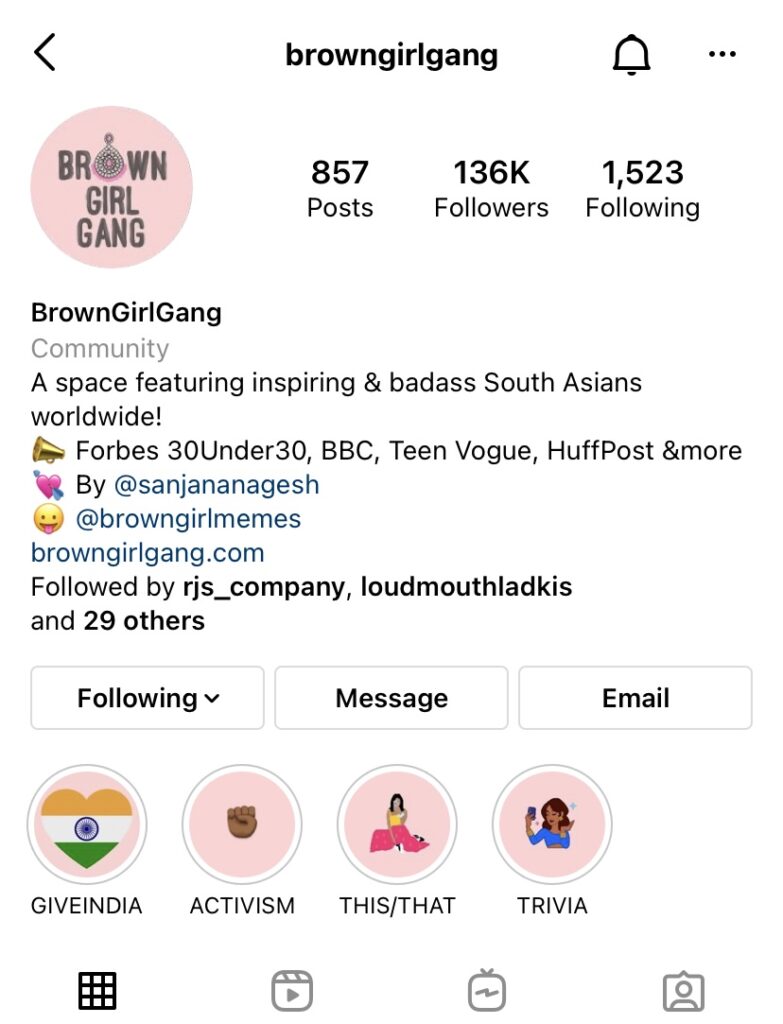
The rise of the South Asian #browngirl and digital diasporic spaces
“A space featuring inspiring & badass South Asians worldwide!” announces the @browngirlgang Instagram bio (see figure 1 above). Founded in 2017 by Australian-born Sanjana Nagesh, the public page has since amassed over 136,000 followers. The account is one of many virtual #browngirl spaces; prominent others include @browngirlmag, @browngirltherapy, and @thatdesifeminist. Applying feminist digital methods to such pages shows promise in advancing scholarship on the South Asian diaspora by offering pragmatic insight into the discourse of its young women today. More broadly, these virtual spaces indicate a growing ‘digital diaspora,’ which Sandra Ponzanesi conceptualizes as Internet-specific, network-oriented, and embedded in wider social practices (2020).
Feminist ethics for researching online alterity
“Margins as Methods, Margins as Ethics” provides a feminist framework for research on groups at the margins of social platforms (see figure 2 below). The authors reflect on terms associated with such work (counterpublics, countercultures, and alternative media), identify subsequent methodological challenges and ethical questions, and propose ostensibly reflexive guiding questions for approaching data collection, analysis, and presentation (Clark-Parsons and Lingel 2020). There is an emphasis on ongoing participant consent and involvement and the co-production of knowledge by researcher and participant. Treatment of participant data is heavily contemplated, particularly in the way that it is safeguarded and compensated for: the authors underline the importance of engaging “with personal data in a manner that does not further disempower groups and communities on the margins” (5).

Pragmatic discrepancies and the study of @browngirlgang
Theoretically, Clark-Parsons and Lingel’s margins-as-methods approach is appropriate, necessary, and considerate of these groups and communities. Nevertheless, discrepancies exist between this broad feminist framework and potential applications to digital methods crafted for contemporary public social media pages. For instance, Perera et al. published a study on @browngirlgang in March 2021 examining how the Instagram platform is “utilized as a virtual counterspace to address societal misrepresentation and both intragroup and external gender oppression” (Perera et al. 275). The researchers found three themes in @browngirlgang’s content: Western women of South Asian descent (WWoSAD) challenging gender norms, redefining gender norms, and celebrating trailblazers and entrepreneurs.
These conclusions were drawn via intertextual analysis of 531 posts spanning from March 2017 to November 2019. A “layering process of contextualization, description, and signification” entailed independently reviewing each post for visual themes, noting intersectional aspects of each gendered ethnic identity portrayal, and enhancing the previous steps through retrieval of textual data (namely, captions, comments, hashtags, and likes) (Perera et al. 278). The methodology demonstrates reflexivity: “the experiences of three of the authors who identify as WWoSAD informed the analysis,” and “at every stage, to assess intercoder agreement, authors discussed their understandings of the various categories until consensus was reached” (278).
Notably, however, the sole mention of researcher-subject interaction is a declaration that per Instagram guidelines, “written permission was obtained from Nagesh to analyze images and text from the @browngirlgang account” (Perera et al. 277). This is not to imply Perera et al. are unethical or unintentionally disempowering in their work, nor that Clark-Parsons and Lingel’s theoretical framework is inapplicable or irrelevant to such study. Rather, this blog suggests that the margins-as-methods feminist approach could be contextualized differently to negotiate a middle ground between obtaining permission once and consistently striving for consent and co-production of knowledge. Specifically, theorizing @browngirlgang and similar accounts as ‘intimate publics’ could support a practical application of feminist ethics in researching public social media pages.
Theorizing public Instagram pages as intimate publics
In 2008, Lauren Berlant introduced the intimate public and its experience of belonging in The Female Complaint: The Unfinished Business of Sentimentality in American Culture. Though “constructed by strangers who consume common texts and things,” Berlant asserted the intimacy of a public sphere stems from an “expectation that the consumers of its particular stuff already share a worldview and emotional knowledge … derived from a broadly common historical experience” (Berlant, viii). Acknowledging commodity culture’s ability to hail and form intimate publics, Berlant labels their members ‘consumer participants.’ When emotional or personal experiences are shared as collective, the intimate public provides “consolation, confirmation, discipline, and discussion about how to live as an x” (viii).
Berlant’s intimate public is nuanced in its consideration of affect, geopolitical complexities, and capitalist systems. As an alternative to the ‘counterpublic’ discourse adapted by Clark-Parsons and Lingel, the intimate public offers language suited to individually-managed public Instagram pages such as @browngirlgang. Specificities include:
Consumer participants (as an alternative to community member and knowledge co-production)
The consumer participant label allows researchers to deviate from ‘community member’ connotations associated with decentralized, rhizomatic networks and is thereby reflective of the account’s nature. Nagesh founded and moderates @browngirlgang, creates and reposts content to followers, and screens the form filled out by all potential collaborators (see figure 3 below). @browngirlgang also sells ‘merch’ to its consumer participants, with their first branded t-shirt currently available for pre-order.
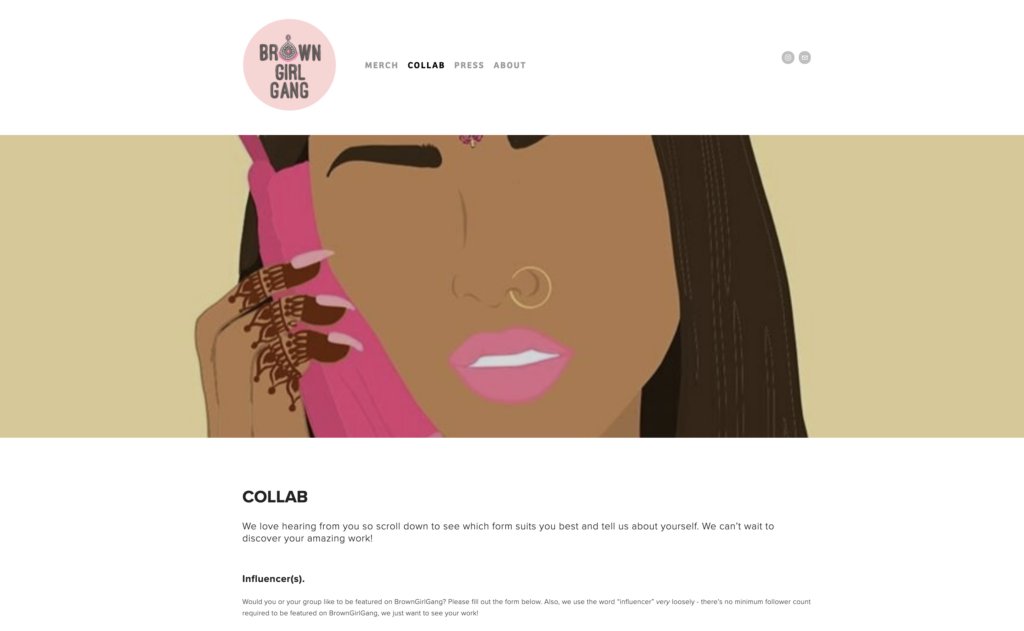
Visibility as power (as an alternative to safeguarding data)
As noted by Perera et al., the account frequently celebrates WWoSAD who are trailblazers and entrepreneurs, such as well-established artists, academics, professionals, influencers, and celebrities (see figure 4 below). Thus, one goal of the @browngirlgang intimate public is arguably to amplify voices and gain power through visibility. “Given limited representation and misrepresentation” in mainstream media, young WWoSAD are bypassing gatekeepers to create and share representative content (Perera et al. 277).
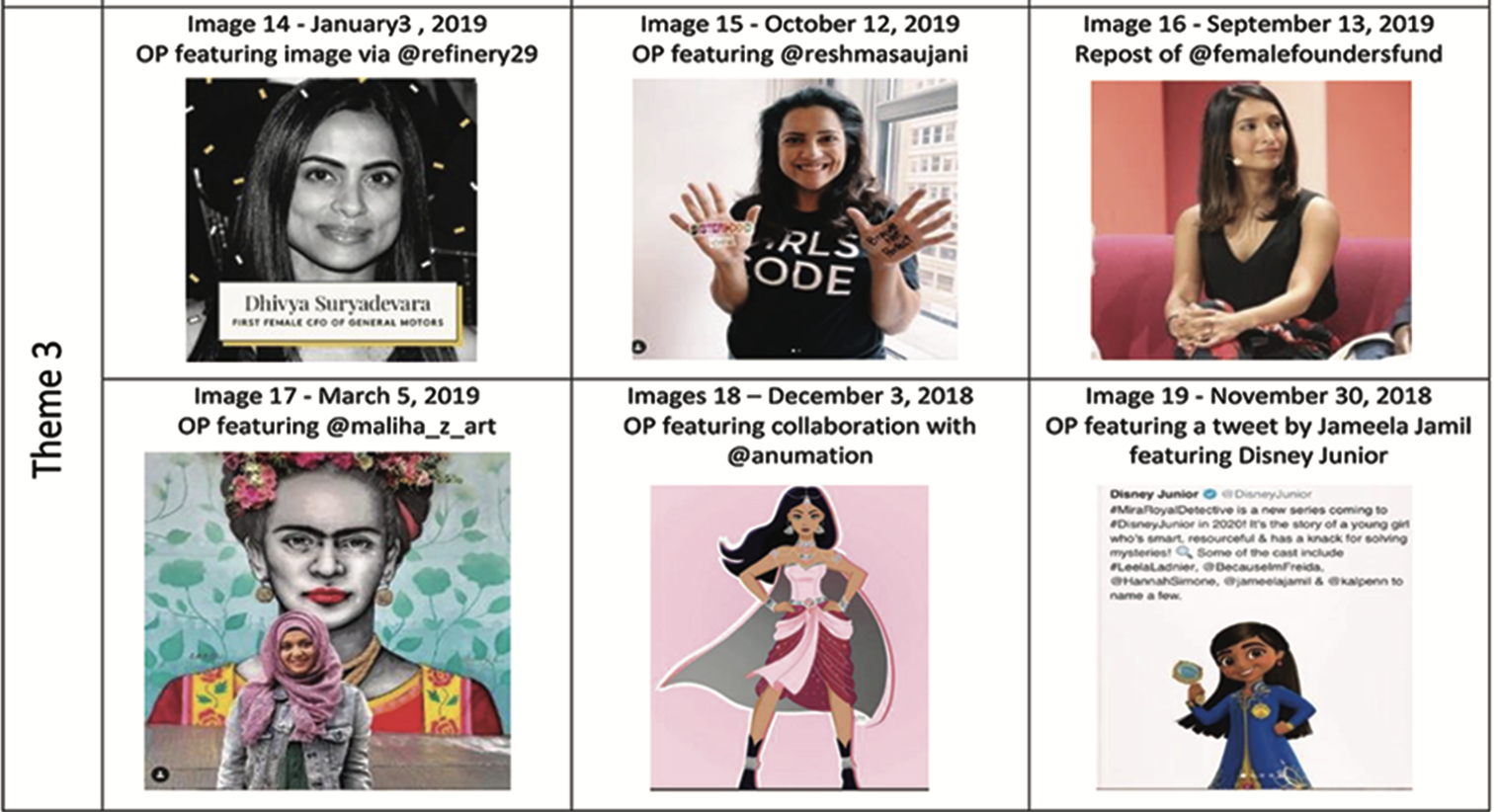
Additionally, Case and Hunter posit counterspaces can be self-enhancing through the articulation of oppression narratives that make the invisible visible (Case and Hunter 2012). Indeed, @browngirlgang endorses a narrative that confirms the oppressed experiences of its consumer participants. Perera et al. recognize these instances in their ‘challenging gender norms’ and ‘redefining gender norms’ findings (see figure 5).
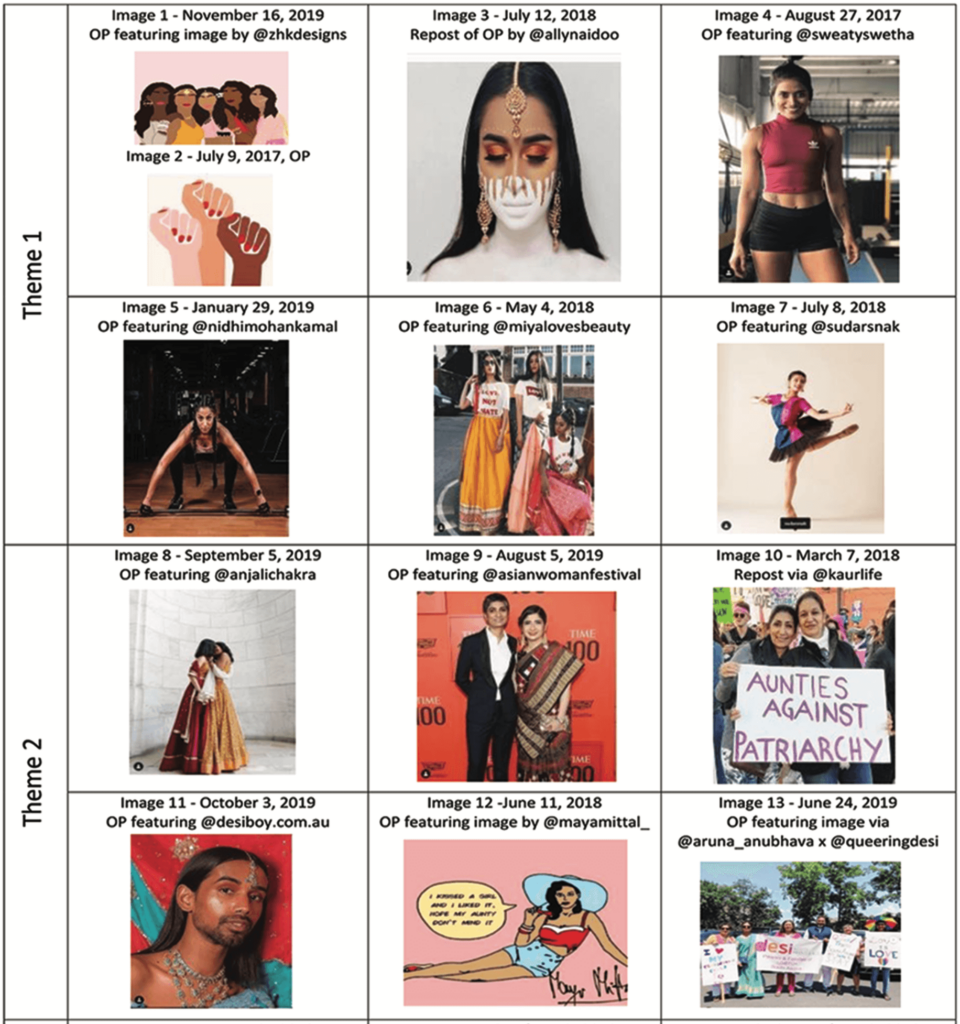
Informed digital analyses (as an alternative to ongoing consent)
In shifting from the counterpublic to the intimate public model, participant consumers can be considered simultaneously as less active co-producers of knowledge and as conscious social media users cognizant that their activity on a public Instagram page is visible to that audience. In departing from questions of ongoing consent, researchers studying public pages can purposefully refine the ethical questions motivating digital methods such as content, visual, and intertextual analysis. Connecting directly with creators and consumer participants remains an eventual possibility for researchers. Often, however, this is an inappropriate first step in the process.
Implications of the @browngirlgang case study and future research
This blog suggests that research of emerging media phenomena requires the adaptation and revision of existing digital ethics frameworks, particularly in the initial analyses of a public social media page. In the case of @browngirlgang, Berlant’s intimate public provides a suitable discourse for applying Clark-Parsons and Lingel’s feminist framework to digital methods and respects the nature of the consumer participant-driven page.
As a next step, these texts could continue to be jointly studied to form alternative margins-as-methods guiding questions applicable to pages such as @browngirlgang. Finally, digital feminist and diasporic spaces are only beginning to be theorized as intimate publics (Kanai 2017; Dobson et al. 2018; Chikafa-Chipiro 2019) (see figure 6 below). Future research in this area could be relevant to digital media studies vis à vis feminist and diaspora studies.
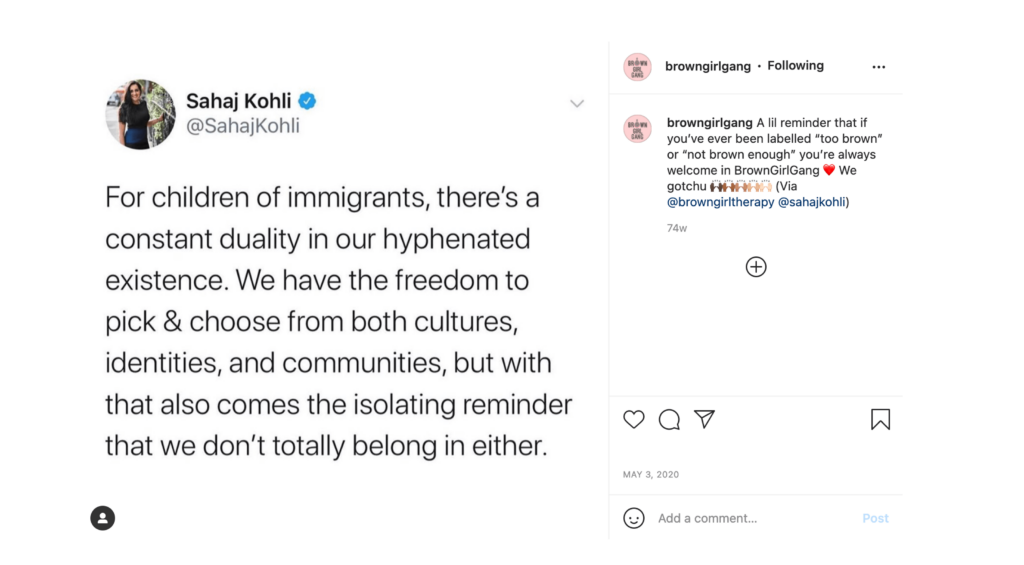
Bibliography
Berlant, Lauren. ‘Preface.’ The Female Complaint: The Unfinished Business of Sentimentality in American Culture, Duke University Press, 2008, pp. vii–xiv, https://doi.org/10.1515/9780822389163-001.
Case, Andrew D., and Carla D. Hunter. ‘Counterspaces: A Unit of Analysis for Understanding the Role of Settings in Marginalized Individuals’ Adaptive Responses to Oppression’. American Journal of Community Psychology, vol. 50, no. 1, Springer US, 2012, pp. 257–270, https://doi.org/10.1007/s10464-012-9497-7.
Chikafa-Chipiro, Rosemary. ‘Racialisation and Imagined Publics in Southern Feminisms’ Solidarities’. Agenda (Durban), vol. 33, no. 3, Routledge, 2019, pp. 8–18, https://doi.org/10.1080/10130950.2019.1683459.
Clark-Parsons, Rosemary, and Jessa Lingel. ‘Margins as Methods, Margins as Ethics: A Feminist Framework for Studying Online Alterity’. Social Media + Society, vol. 6, no. 1, Jan. 2020, p. 1–11, https://doi.org/10.1177/2056305120913994.
Dobson, Amy Shields, et al. Digital Intimate Publics and Social Media. Palgrave Macmillan, 2018.
Kanai, Akane. ‘Girlfriendship and Sameness: Affective Belonging in a Digital Intimate Public’. Journal of Gender Studies, vol. 26, no. 3, Routledge, 2017, pp. 293–306, https://doi.org/10.1080/09589236.2017.1281108.
Perera, B. Yasanthi, et al. ‘This Is Who I Am: Instagram as Counterspace for Shared Gendered Ethnic Identity Expressions’. Journal of the Association for Consumer Research, vol. 6, no. 2, The University of Chicago Press, Apr. 2021, pp. 274–285, https://doi.org/10.1086/713288.
Ponzanesi, Sandra. ‘Digital Diasporas: Postcoloniality, Media and Affect’. Interventions (London, England), vol. 22, no. 8, Routledge, 2020, pp. 977–993, https://doi.org/10.1080/1369801X.2020.1718537.